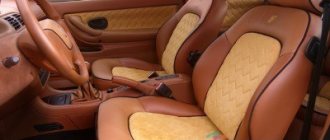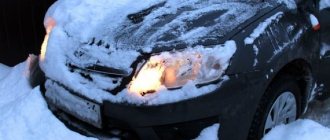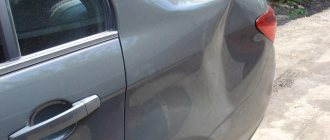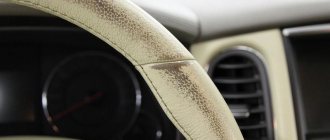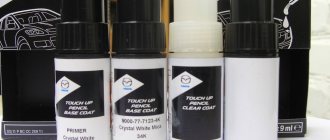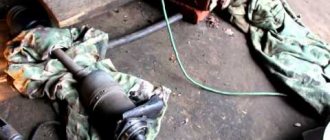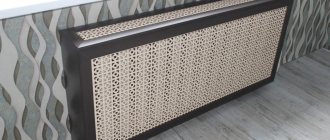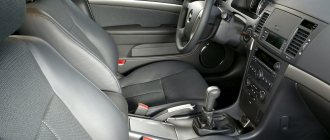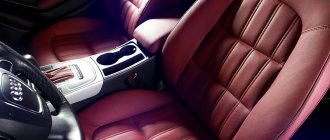Piling work is one of the most labor-intensive and most difficult in car body repair. Dents, scratches, peeled paint are not the worst thing in an accident. The situation is much more serious with the so-called “curvature” of the body, when the symmetry of the car is broken.
Why is it important to seek repairs on time?
Firstly, when the planes in which the suspension elements operate are distorted, accelerated wear of the parts occurs, which ultimately leads to even more expensive repairs.
Secondly, if the geometry is broken, problems may arise with closing/opening the doors, hood, and trunk. Visually, there may be inaccuracy in the gaps between body parts.
Thirdly, the trajectory of the vehicle changes, including when braking. In some cases, even with a slight violation of the geometry, the driver feels it quite well when driving.
Don't rush to change your car! It can be restored!
Before renovation
After renovation
- Our services
- Prices for work
- Work examples
- Repair technology
In particularly difficult cases, when the damage is so severe that it would seem that repairing the body is impractical, the slipway comes to the rescue. Quite often welding work is used along the way. Parts that cannot be repaired are cut off, and used parts are welded in their place. Thus, slipway work guarantees the complete restoration of the car after serious damage, for example, as a result of an accident.
Promotion!!! 5% discount on any type of work when making an appointment in advance or when estimating the cost of work from a photo!
- Make an appointment at a car service center for repairs
- Estimate the cost of repairs from photos
* When estimating from a photo, the price is reported without taking into account the discount. Thus, the final cost will be less than 5% of the calculated one.
* Discount cannot be combined with other promotions and offers.
How to stretch car bodies
Pulling out a car or a car body at a cost even if there has been a minor accident or other damaging factors is quite expensive. Although, it seems that there is nothing difficult when performing such work. The main thing is desire, free time and the necessary tools, then repairing the car body is possible on your own. How the body is stretched and pulled out, let’s figure it out step by step:
First, you need to determine the amount of work required, and then the car must be washed, then thoroughly inspected.
First of all, you need to make sure that the spatial geometry of the body is not broken. You can check the geometry by measuring the distances between all control points. When there is no information on these points, then you can navigate by the visible power structure. For example, the distances between the suspension mounts and engine mounts are symmetrical.
When the geometry of the body is damaged, then restoring the car with your own hands will be extremely difficult. Because you not only need to know how the body is pulled, you need specific equipment, in fact, you need a whole stand that allows you to pull the body in any desired direction. The equipment is bulky and expensive.
Of course, you can try to use the means at hand, for example, guy ropes or jacks, however, it is very difficult to efficiently restore the car body using such means.
If you do not have the opportunity to use the appropriate stand (for example, rent), then there is no point in purchasing a stand - repairs will be cheaper in the service.
The second thing you should pay close attention to is rust stains. Moreover, through corrosion cannot be ignored. The appearance of a rusty spot on the surface does not mean that the body is not completely rotten - there may already be no metal under the paint. Such places should be checked (with a simple tap, everything will immediately become clear by the sound).
As a rule, body repairs begin only because minor damage appears in a visible place. However, it won’t hurt to check the other points.
And if the dents are not large, there are no tears or pulling out of the metal, and the stiffening ribs are not affected, then they can be straightened out carefully, and subsequent painting will not be needed. This is achieved by restoring the shape through mechanical action, while preserving the paint layer; the work is complex and requires experience.
In more complex work, it is not possible to preserve the paintwork, so after straightening, priming and painting are required.
Geometry restoration
The process consists of stretching a certain point of the body in three-dimensional space, for which it is necessary to “calculate” the desired point geometrically, and then predict the behavior of the body when stretched, and this requires some experience.
Therefore, you need to consider a simpler, often necessary type of repair.
First you need to replace parts of the body kit, which will be cheaper and easier to replace entirely than to restore. For example, doors, fenders, hood, trunk, etc.
Then, the consequences of the resulting corrosion are eliminated. Pieces with through holes are cut out entirely to solid metal, then the patch material is welded.
If corrosion has not yet reached such a scale, then we simply clean the rusty surface down to the metal.
Small defects (for example, shallow dents that appear on smooth surfaces) are the easiest to correct. They are called “poppers”, because of the popping noise during restoration - it will be enough to heat or apply mechanical force on the other hand, the dents will return with a pop to their original state.
Repairing serious damage will require removing the paintwork. To do this, it is convenient to use a grinding machine with an attachment. The main thing when grinding is not to overheat the metal (so that the surface does not turn blue), otherwise its properties will change and it will continue to deteriorate, even under a layer of putty and paint.
That’s when, along the perimeter of some of the dents, the metal stretched out quite strongly (it turned out to be a deep dent). Then it is necessary to “bring it back” so that the metal returns to its original form. It is necessary to act along the perimeter, smoothly stretching the surface to its original form. You will need a small anvil and a rubber (or wooden) hammer. The use of an iron hammer is undesirable, since it itself leads to deformation of the tin.
You apply the anvil to the outer edge of the resulting dent, and use the hammer from the inside, returning the metal to its place.
If the metal is stretched too much, then straightening it using the previous method is very difficult. However, the paintwork will also need to be removed. In addition, this type of repair requires a construction hair dryer and even a spot welding machine using graphite electrodes.
The process is actually similar to the previous one - you need to straighten the dent from the edges to the center. Only first, spot heating of the bent metal is used, and then mechanical action is applied. After heating, the metal becomes more ductile and pliable. You select the heating level experimentally.
When using an industrial hair dryer, there will be no difficulties. However, the use of spot welding requires attention, otherwise it is possible to burn through the iron. The shape of the electrode is selected according to the shape of the dent; it is more convenient to correct a round dent with a round electrode, and a long one with a wide one.
To restore the shape, it is necessary to reach the other side of the part, however, this can be impossible or difficult. In this case, you should try to fix the dent from the outside.
For this purpose, the electrode is welded (grabbed) to the place on the surface that needs to be pulled out. Then, using a special tool or a reverse hammer, the metal is pulled out. Then the electrode is broken off and the surface is ground. Here is a fairly simple and most effective method for restoring the shape when pulling out a car body with your own hands, since the only expensive equipment needed is a welding machine. And you can easily make a reverse hammer yourself.
How to pay TWICE LESS for GASOLINE
- Gasoline prices are rising every day, and the car's appetite is only increasing.
- You would be happy to cut costs, but is it possible to live without a car these days!?
But there is a completely simple way to reduce fuel consumption!
Don't believe me? An auto mechanic with 15 years of experience also didn’t believe it until he tried it. And now he saves 35,000 rubles a year on gasoline! Read more about this at the link. KuzovSpec.ru
Do-it-yourself car body exhaust
Body stretching is a very complex process, which is usually performed after an accident, when all distortions in the geometry of the car body are eliminated by applying the opposite force to that received during the accident.
What does it take to pull out damage?
To correct damage of this nature, special tools are always used that can return any part of the car to its previous state; these are hydraulic and screw jacks, which can be used on:
- doorways,
- hood and trunk lid,
- openings of the windshield and rear glass.
How much a body stretching costs always depends on the method of work, but sometimes you can repair a car after a minor collision, for example, unsuccessful parking, with your own hands.
To perform straightening with your own hands using the heating method, you need to arm yourself with:
- rubber or metal hammers of different weights;
- protective equipment - gloves, glasses;
- heat source - burner or hair dryer.
Body pulling
How it works?
Leveling the body shape using jacks should occur in several stages:
- Dismantling all parts that in any way interfere with repairs and access to damaged areas.
- Installing the car body on special supports.
- Installing a hydraulic jack and determining the impact angle.
- Starting the hood. During the pulling process, it is always very important to take measurements with a special body ruler and compare the indicators according to the control points of the primary body drawing.
- While pulling, the mechanics also “tap” with a hammer on all the distortions and bends of the metal, which helps give the body its original shape.
- In cases where the first time it was not possible to pull the parts into their previous position, repeated pulling with squeezing is performed, and everything is left in this position for a day for the metal to “get used to.” If the damage is very extensive, then two or three jacks can pull out the dent at once.
Removing dents on a car using a reverse hammer
Straightening dents using a reverse hammer is performed when the driver has difficulty accessing the damage site, or the parts being restored cannot be dismantled. Repairing body dents like this usually requires subsequent painting of the repaired part. To straighten a dent, perform the following steps:
- Clean, dry and degrease the surface to be restored. Remove traces of corrosion.
- One end of the reverse hammer is attached to the center of the damage. The operation is performed using a special suction cup or applicator.
- Straightening is carried out by gradually increasing blows of the weight on the hammer handle.
- After completing the restoration of the exterior of the body, the hammer is disconnected.
Car body stretching
Hello dear readers of the kuzov.info blog!
This article will be of interest to beginners in auto body repair who are interested in the process of stretching a car body after an accident.
We will look at some points that are known to professionals, but unclear to beginners.
So, before repairing a damaged car body, it is important to carefully examine and understand the logic of the damage. What has shifted and where, what can be repaired and what needs to be changed. It is necessary to determine whether the geometric parameters of the body have been changed. If there is an impact to the front or rear of the vehicle, the front or rear side members may be damaged, respectively. In case of side impacts, the side pillar of the body, as well as the sill and floor, may move. The full picture will be visible after disassembling the body, removing damaged panels, radiators, headlights, etc.
The repair begins with putting into place all the power elements that affect the geometric parameters of the body. Even if some of the power elements require replacement, they still need to be pulled out and, as far as possible, the “geometry” of the body is returned to the required dimensions. This will return the attachment points of elements that require replacement to their places.
Measuring the “geometry” of the body
To understand where and how much the power elements of the body have shifted, various measuring systems are used to measure geometric parameters.
Most often, in garage workshops and small car repair shops, rulers are used to measure body geometry, as well as simple tape measures.
It is not always convenient to use a tape measure, since there may be various obstacles on the path of the two points between which you need to measure the distance (especially in the engine compartment). A measuring ruler makes measurements quite easy.
It is important to check the diagonals of the shock absorber cups and the mounting points of the suspension to the body. These parameters affect the wheel alignment setting.
Jib for pulling out the car body
In order to pull out the power elements of the body, as well as, in general, perform pulling operations, bodybuilders use a slipway. The slipway is designed for rigid fastening of the body and subsequent pulling out of its damaged elements. Fastening is usually done at the sill flanges. This is necessary so that the car does not move along with the pulled element.
Many garage body repair specialists do without the use of a slipway. To do this, garages use concrete hinges that are located along the perimeter of the garage floor. They serve both to pull the body (a winch or hydraulic tie is attached to them) and to secure the car with chains on the reverse side of the pulling force. If the front is pulled out, then the back of the car is tied with chains to the hinges; if the back is pulled out, then the front part is tied, accordingly. Also, stops are used when applying lateral pulling force.
More often, however, a slipway is used. Garage body repair specialists purchase stocks suitable for use in small workshops, and also copy and manufacture the designs of factory stocks, as well as assemble homemade stocks that they have come up with on their own. Large car repair shops use platform-type slipways.
Rules for pulling a car body
- The principle of pulling out a damaged element is to apply force in the direction opposite to the force of impact during an accident.
- During the pulling process, it is necessary to tap the folds on the metal formed during deformation. This is implemented as follows: the pulling force aligns the element and then the process seems to be suspended; after tapping, the pulling resumes and the metal fold is leveled.
- There is such a thing as “constriction”. The idea is to tighten the damaged element a little more than necessary, as it will still come back a little.
- Stamped metal can be said to have a “memory”. That is, all deformed body parts are under tension. The bodybuilder’s task is to relieve these stresses, aligning damaged elements and “helping” the metal return to its original state.
- Sometimes, when pulling out the power elements of the body, heat is used. This helps stretch out stubborn areas.
- Also, sometimes you have to make cuts to loosen stubborn folds.
You can also read the article on car body alignment, which discusses body repair technologies in detail.
Hydraulic stretch
Hydraulic stretching is used in body repair for stretching using the extrusion method. There are various hydraulic extensions that provide different forces from 4 tons and above. An example of the use of this device is pulling out the side pillars of the body by squeezing it out from inside the passenger compartment. Spars that are shifted to the side can be straightened. And also, straightening deformed doorways and windshield and rear window openings. Typically, bodybuilders purchase a set that includes several types of extensions of different lengths, attachments, the extension itself and a hydraulic pump, but you can buy each element separately.
Hydraulic coupler
The hydraulic tie acts like the previous device, but on the contrary, it tightens. Can be used for pulling, as an alternative to a winch.
Body clamps
To directly attach a chain from a pulling device (winch or tie) to a damaged element, various body grips are used.
Sometimes metal loops and plates with loops are welded in places where it is impossible to use a body grip, or in the absence of special grips.
Some modern body clamps have a self-clamping design. By adding pulling force, the gripper is compressed more, which prevents it from slipping out.
Pulling out the shock absorber cups
As mentioned above, when measuring the “geometry” of the body, it is important to check the location of the shock absorber cups. The diagonals of the segments are measured from the centers of the upper bolts for attaching the struts to the bolts for attaching the hood brackets to the body. Also, the diagonal distances between the centers of the bolts of both body cups are checked.
When moving the shock absorber cups, a special device is used. It allows you to pull the cup in any direction.
Gaps
After pulling out all the power elements and replacing damaged body parts that cannot be restored, the front body panels are tried on. If all the power elements are pulled out correctly and all the fastening points are in place, then all the gaps of the front body panels should be smooth and identical on both sides of the car.
All doors, hood and trunk lid should close without significant force and not touch adjacent body panels. You can read about how to adjust the clearances on your car here.
The unevenness of the gaps can show what and where is undertightened or overtightened. The gaps thus provide information about whether the body is correctly extended.
To summarize, we can say that if you have the necessary, not the most expensive tools and devices, as well as knowledge and experience, you can recover complex damage to the car body even in a garage workshop. Experience, of course, is important. If you have insufficient experience, it is better to start pulling out damaged bodies that have slight displacements of the power elements.
Straightening damaged body panels requires no less high skill. Having mastered the basic techniques of straightening, you can straighten quite complex damage. Read about the method of straightening dents using a straightening hammer, support and a body smoother in another article.
kuzov.info
Gaps
After pulling out all the power elements and replacing damaged body parts that cannot be restored, the front body panels are tried on. If all the power elements are pulled out correctly and all the fastening points are in place, then all the gaps of the front body panels should be smooth and identical on both sides of the car.
p, blockquote 28,0,0,0,0 –>
All doors, hood and trunk lid should close without significant force and not touch adjacent body panels. You can read about how to adjust the clearances on your car here.
p, blockquote 29,0,0,0,0 –>
The unevenness of the gaps can show what and where is undertightened or overtightened. The gaps thus provide information about whether the body is correctly extended.
p, blockquote 30,0,0,0,0 –>
To summarize, we can say that if you have the necessary, not the most expensive tools and devices, as well as knowledge and experience, you can recover complex damage to the car body even in a garage workshop. Experience, of course, is important. If you have insufficient experience, it is better to start pulling out damaged bodies that have slight displacements of the power elements.
p, blockquote 31,0,0,0,0 –>
Straightening damaged body panels requires no less high skill. Having mastered the basic techniques of straightening, you can straighten quite complex damage. Read about the method of straightening dents using a straightening hammer, support and a body smoother in another article.
p, blockquote 32,0,0,0,0 –> p, blockquote 33,0,0,0,1 –>
Car body repair and restoration: step-by-step instructions and device
Even if you get into a minor accident, the cost of restoration work can be quite high. It seems that the complexity of the work is small and there is nothing difficult in carrying it out. If you have a great desire, a little time, the necessary resources and tools, then restoring the body yourself is a completely feasible process. Let's look at restoration technologies in stages.
Geometric characteristics
It is necessary to make sure that after an accident or any other negative factors, the spatial geometry of the car body remains without significant changes. This can be done by measuring the distances between so-called control points. If there is no information on these points, then they focus on a clearly visible power section. Thus, there must be symmetrical distances between the mounting elements of the suspension and engine. If the geometry of the body is broken, then restoring the car body is possible, but this operation will require a huge investment of money and effort. This is a very labor-intensive process. The thing is that to perform high-quality work of this level you need to have a whole range of equipment. This is a slipway on which the body is pulled out in the required order.
Naturally, the cost of such a complex is quite high. Specialists in small garages use improvised means and tools. These can be different stretch marks or jacks. With the help of such simple devices it is possible to carry out restoration work, but it is difficult to talk about quality. If it is not possible to use a special stand for work, then there is no point in buying it, this equipment is very expensive. Repairs at a service station that does body work will cost much less. So, in Moscow, the price for body restoration starts from 4 thousand rubles (pulling out minor distortions on the slipway).
How to restore geometry
If you still want to solve the problem with your own hands, then the process consists of the so-called pulling out the point of the damaged area. But first you need to calculate this point, calculate it, and then predict how the body will behave during the impact.
First, damaged parts of the body kit are replaced, which are cheaper to buy new than to restore. These could be doors, bumpers, hood covers, and trunk lids. After this they move on to stretching.
Anti-corrosion
You should be very careful about areas of corrosion. Also, through holes should not pass by the master. If there is only a small spot of rust on the paintwork, this does not mean that the metal is not completely rotten. There may be no metal under the paint at all. If there is a piece of the body in which through holes have formed, then it is completely cut out until solid metal appears. After this, a patch is welded in place of the cut piece. If the rust is not that severe, then restoring the body will involve stripping the affected areas back to bare metal.
Small dents
Most often, repair work is started due to a large number of small damages. If there are really minor deformations, where there is no metal pulling, tears or other consequences, then these defects can be corrected without repainting. The shape is restored mechanically with full or partial preservation of the paintwork. But you need to understand that the process will require a huge amount of time. Although such defects are the easiest to fix. Professionals call them “flackers” because of their characteristic popping sounds. You just need to heat the area a little or act on it mechanically from the reverse side. The dent will return to its normal position with a characteristic sound. If welding is required or there is a need to replace a part, then painting work is simply indispensable. But there are advantages to this - you can use simpler restoration methods without using putty.
Serious defects
Restoring a car body if it has serious dents will require complete removal of the paintwork. A grinding machine and an appropriate attachment are suitable for this. The most important thing in this process is to work so as not to overheat the metal. When the metal parts of the body become very hot, the properties of the metal will begin to change. If the metal around the perimeter of the damage is very stretched (for example, the dent is very deep), then it is returned to its original form. Here it is necessary to apply force and act around the perimeter, while smoothly bringing the body section back to its original form. A small mallet and anvil works well for this type of work. A metal hammer is not suitable for these purposes, as it will deform the metal. The anvil is applied to the outer part of the dent, and light blows are made from the inside with a mallet. The metal will return to its rightful place.
We restore severe deformations
When areas are very elongated, restoring the body using the method described above will not help. The process will be very difficult and time-consuming. You will need to completely remove the paintwork. Also, repairing damage requires an industrial powerful hair dryer and a spot welding machine. The welding machine requires graphite electrodes. The technology for restoring body damage is completely similar to the previous method - you need to straighten the dent, starting from one point on the perimeter, and then gradually approach the center. But they no longer use a mallet with an anvil, but heat the metal pointwise and then act mechanically. Heated tin becomes more plastic and pliable. How hot to heat depends on the metal. The temperature is selected experimentally. There are no difficulties with an industrial hair dryer. But if a spot welding machine is used, there is a risk of burning the body almost right through. Electrodes have different shapes and are selected depending on the type of damage and the shape of the dent. Circular deformations are corrected with a thin electrode, long ones with a wider one.
Using Spot Welding
Repairs and restoration of a car body, when you need to return it to its original shape, can be very labor-intensive. It is not always possible to reach the damaged area from the reverse side. In this case, you can try to correct the defect entirely from the outside. In order to do this, use a welding electrode to grab the metal in the area that needs to be pulled out. Then, using special devices or a reverse hammer, the metal is pulled out. The graphite electrode is then broken off. The welding site to the metal is ground.
Soldering metal onto a dent
In this case, the defect is not pulled out. Body restoration is done a little differently. This does not imply stretching the deformation. Special solder is soldered into the formed dent. This method allows you to almost perfectly remove any defect. The result will be amazing. A thickness gauge will not be able to detect traces of repair. This procedure requires solder, flux and acid, as well as a fairly powerful soldering iron. The working surface should be thoroughly cleaned and then tinning. Next, the rest of the volume is fused. The most important thing is that there is enough solder. When the process is over, the surface is thoroughly washed. Flux is a chemically active substance. The surface restored in this way will not be completely ideal. It is necessary to additionally grind and remove excess solder. They also form the correct shape. Next, the place is polished, and only then can you get a good result.
Conclusion
As you can see, body restoration and repair can be performed in various ways. Naturally, it will not be possible to solve a serious problem in a garage. But it is quite possible to cope with minor deformations.
fb.ru
Leveling with reverse action tools
This method can be divided into two types. The first is that a vacuum tool is used for the job, and the second type involves the use of a reverse hammer. Both methods work on a similar principle, and you can understand the procedure by watching a video on this topic.
The technology of straightening with a vacuum tool is as follows. A tool with suction cups is attached to the damaged area of metal and with physical effort the dent is pulled out to its normal position.
This method is often used in cases where the paintwork remains intact at the damage site, since pulling with suction cups allows you to preserve the paint and avoid cosmetic repairs.
If a reverse hammer is used, then painting work cannot be avoided. The technology for pulling out a dent using this method is as follows: hooks made of wire are welded to the damaged area, a reverse hammer is connected to them, and the metal is pulled out to its normal position by impact forces. After this, the hooks are cut off, and the body is sanded and painted.
Another way to pull out a dent using a reverse hammer is to drill a hole. The threaded tip of the tool is threaded into this hole, and a washer is put on the other side and the nut is tightened. After leveling, the hole is puttied or welded. It should be noted that this method will be difficult to perform in cases where there is no access to the damage site on both sides. All these techniques require caution and some experience, so you first need to watch several videos with different options for such straightening.

